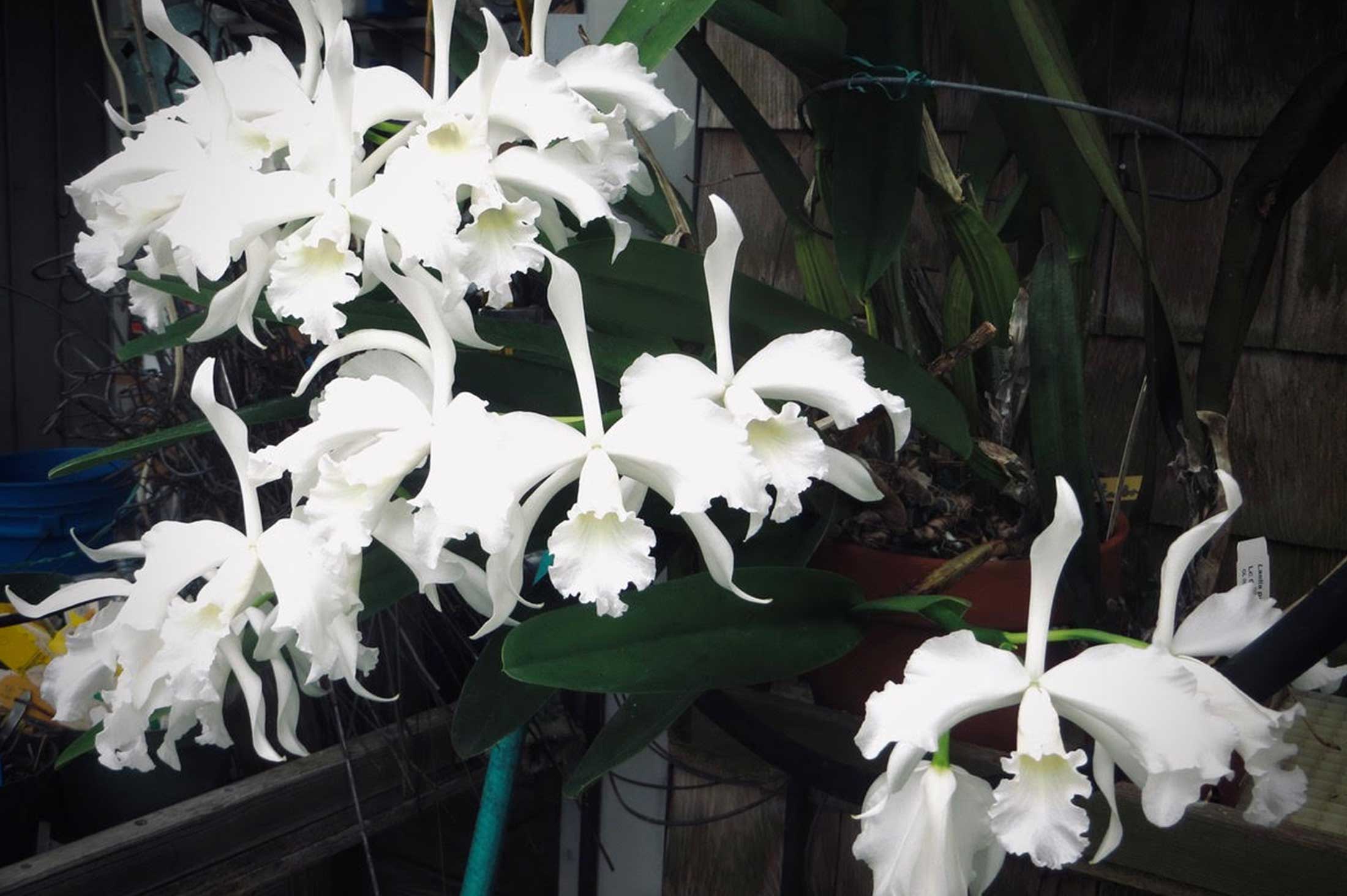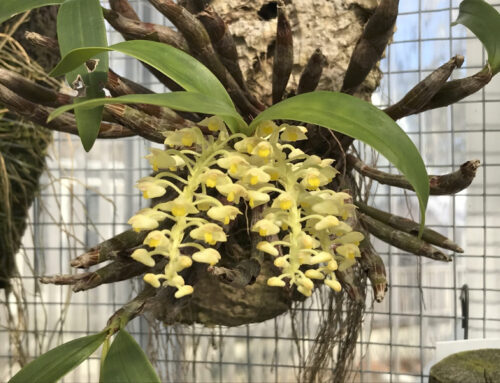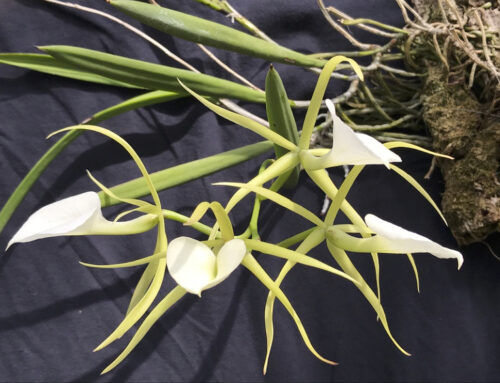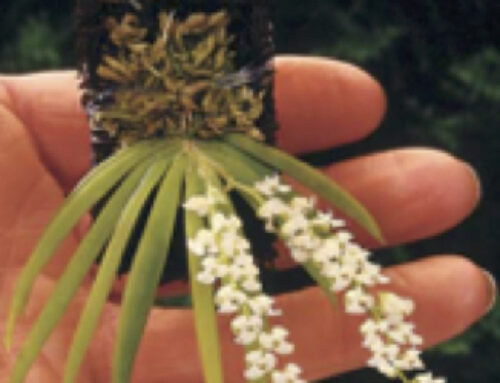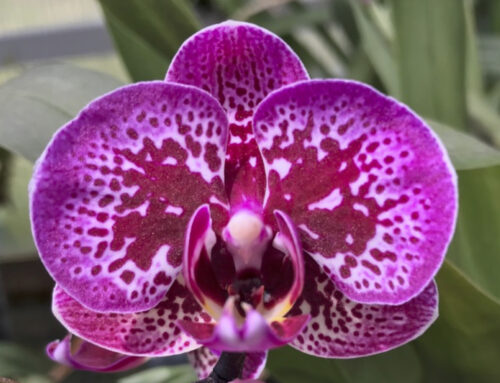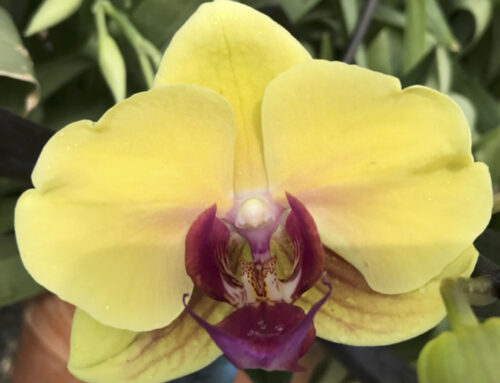By Susan Jones
Reprinted from the FEBRUARY 2003 issue of Orchids — The Bulletin of the American Orchid Society. Copyright American Orchid Society — aos.org
Whiteflies (Aleurothrix) are sucking insects, related to aphids and scales, that feed on plant sap. The adults are small (approximately 1/16 inch ([1.5 mm] long), with a fine white powdery wax over their four white wings and body. Both the adults and immature whiteflies are found on the undersides of leaves. In sufficient numbers, whiteflies will weaken and eventually kill this host plant.
Whiteflies can reproduce rapidly in the enclosed area of a greenhouse and make c cloud of white when disturbed.
Life Cycle
Female whiteflies lay eggs on the undersides of a plant’s upper leaves. Following an incubation period of four to 12 days, those eggs hatch out into crawling nymphs. The nymphs commence feeding by piercing the leaf cells and sucking the plant’s sap. Within approximately six weeks, depending on temperature, the nymphs grow, molt and reach their four-winged adult stage. The adults live for one to two months..
Symptoms
Among the many possible causes of an orchid’s failure to thrive, whitefly is a significant consideration. Although they are quite small and not necessarily immediately obvious, they can eventually kill a plant if left unchecked.
Signs of whitefly on orchids include weakened plants, damaged or unhealthy new growth, yellow mottled leaves that eventually drop, the presence of sooty mold or ants and, most especially, a cloud of tiny white insects arising from an affected plant when it is moved or disturbed.
Because the whitefly larvae feed on the plants’ sap, plant vigor is severely impacted. The honeydew (a sugary liquid) excreted by the larvae encourages growth of sooty mold, is unsightly and reduces the light available to the plant for photosynthesis, thus further weakening it. Ants are also attracted to this honeydew and will farm whitefly in much the same manner as they farm aphids.
Control
A clean greenhouse or growing area will help to minimize potential insect pest problem. A minimum of two weeks’ quarantining any new plant or cutting that enters the growing area can also help curtail the introduction of new pests and diseases.
According to the University of Connecticut’s Integrated Pest Management department, certain nonorchid plants make excellent host plants for whitefly. Among these are astilbe, chenille plant, columbine, chrysanthemum, dicentra, flowering maple, gerbera daisy, glory bower, hibiscus, lavender, lantana, malva, monarda, mints, Martha Washington geranium, primula, salvia, scaevola, tomato, rosemary (and many other herbs), verbena and zinnia. To eliminate a whitefly problem, it may be necessary to remove these other favored hosts from the growing area.
For the overall health of an orchid collection, it is a good idea to check each plant (for smaller collections) or spot-check plants or groups of plants (in a larger collection) and the growing area at least once a week for signs of anything unusual – pests, disease, environmental damage, etc. In this way, an invading insect can be detected and treated before it becomes an infestation. For whiteflies and some other flying insect pests, yellow sticky cards are a useful part of that monitoring program. The insects are drawn to the color of the card and become adhered to its sticky coating. The cards can be placed among plants, and, in a greenhouse, should also be placed near doors and vents. Whether purchased or homemade, these simple insect traps can provide early warning of new pests in the growing area.
Treatment Options
Several natural enemies including predators, parasitoids and insect pathogens are commercially available for use in controlling whitefly populations.
- Many greenhouse supply companies sell helpful insects (insect predators and parasitize pest insects. Those that are useful for treating whitefly include ladybugs, praying mantids, assassin bugs and parasitic wasps. They are not usually a cure for the infestation, but instead reduce the whitefly population to the point where it is no longer a significant threat to your plants. These helpful insects are best used in a greenhouse or enclosed structure.
- Encarsia formosa and Eremocerus sp. Are small parasitic wasps that attack whiteflies. The adult wasp lays its eggs in whitefly nymph. The parasitized larvae then die. Caution must be exercised when using parasitic wasps, as they may be sensitive to pesticide residues on plants or in the greenhouse, and the adult wasps may be attracted to yellow sticky cards. Plan in advance so that insecticides with a long residual effect are not used before the wasps are released. Insecticidal soaps,; horticultural oils and many insect growth regulators are more compatible with the use of parasitic wasps than other stronger insecticides.
- A common fungus can also be employed as a control for whitefly. Beauvaria bassiania is available commercially as Naturalis O and Botanigard from garden and greenhouse supply firms. The fungal spores penetrate the insect’s cuticle. Toxins produced by the fungus as it grows within the insect weaken the whitefly’s immune system, eventually killing it. Spray the growing area thoroughly when using this pathogen, as it must actually contact the insect to work. Do not use any fungicides concurrently in the growing area, or even use a sprayer that has been used previously for fungicides, as this can severely reduce the effectiveness of the treatment.
- Like aphids, whiteflies excrete honeydew that attracts ants, and as with aphids, ants will “farm” whitefly to obtain this food. If ants are present, it is necessary to eliminate their population as well to eradicate the whiteflies. One method of ant control is to mix syrup of boric acid powder, sugar and water, and place small containers of it throughout the growing area. The sugar draws the ants just like honeydew. They will eat the poison and take it back to the queen. This should remove the ant colony within a few days. Another option is Orange Guard, a 100 percent biodegradable and water-soluble insecticide made from oranges that is considered safe for use around humans, pets and food, and is effective against ants.
- Systemic insecticides (those that enter the plant cells and affect insects that consume any part of that plant) registered for use on orchids and deemed effective against whitefly include Diazinon, Malathion and Pyrethins. Some of the topical remedies labeled for use against whitefly and safe for orchids are Spectracide Houseplant and Garden Insect Spray 1 and Safer Insecticidal Soap. Enstar II Insect Growth Regulator may also be used against whitefly. It employs excess juvenile-growth hormones to cause sterile eggs in adult whiteflies and incomplete development of immature-growth stages. An added benefit in using Enstar is that insects do not develop a resistance to this treatment. It is also considered safe around humans and pets.
As always, use of any insecticide should be in strict compliance with the manufacturer’s recommended dosages and safety precautions. In the spring, be especially observant for whiteflies that can injure the health of your orchids
References
http://www.geocities.com/RainForest/Vines/7040/article.html#Whiteflies
This Web article “Orchid Pests and Diseases,” from the book Growing Orchids in Canberra by Jane Wright provides a great deal of useful information about whitefly as well as many other insect pests and diseases affecting orchids
http://www.suite101.com/article.cfm/garden_pests/17104
Whitefly, by Carla Goodloe, shares a grower’s experiences in battling this nuisance insect.
http://www.hort.uconn.edu/ipm/homegrnd/htms/48ghwfl.htm
The University of Connecticut’s Integrated Pest Management Web site is a gold mine of information about a wide variety of insect pests and pest-management strategies. “Managing Whiteflies in the Greenhouse,” by Leanne Pundt, the Extension Educator for Commercial Horticulture at the University of Connecticut, contains helpful photographs, a lifecycle chart for the whitefly and links to other useful information about whitefly as well.
—
Susan Jones was the editor of Awards Quarterly and assistant editor of Orchids. American Orchid Society, 16700 AOS Lane, Delray Beach, Florida 33446

